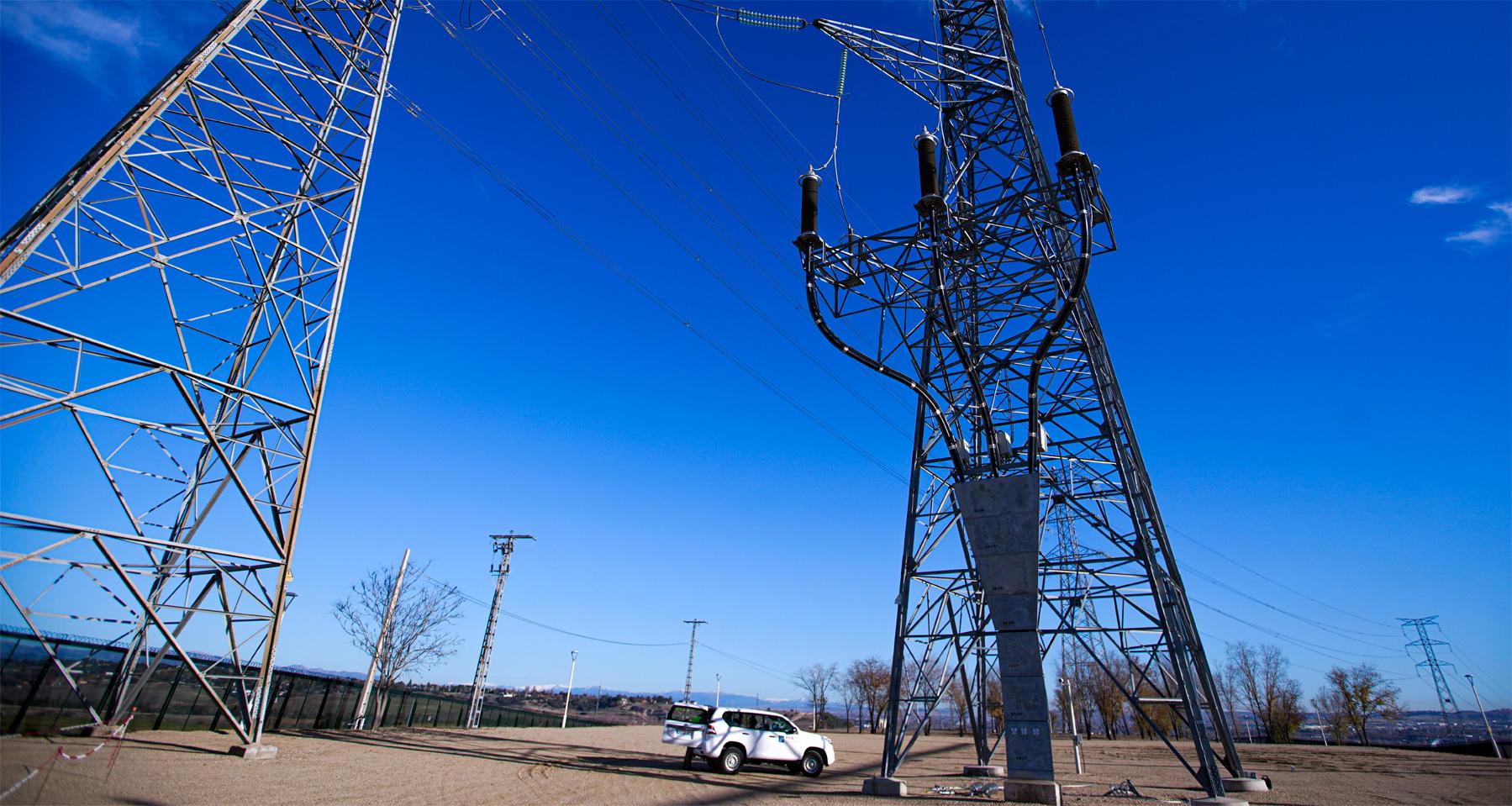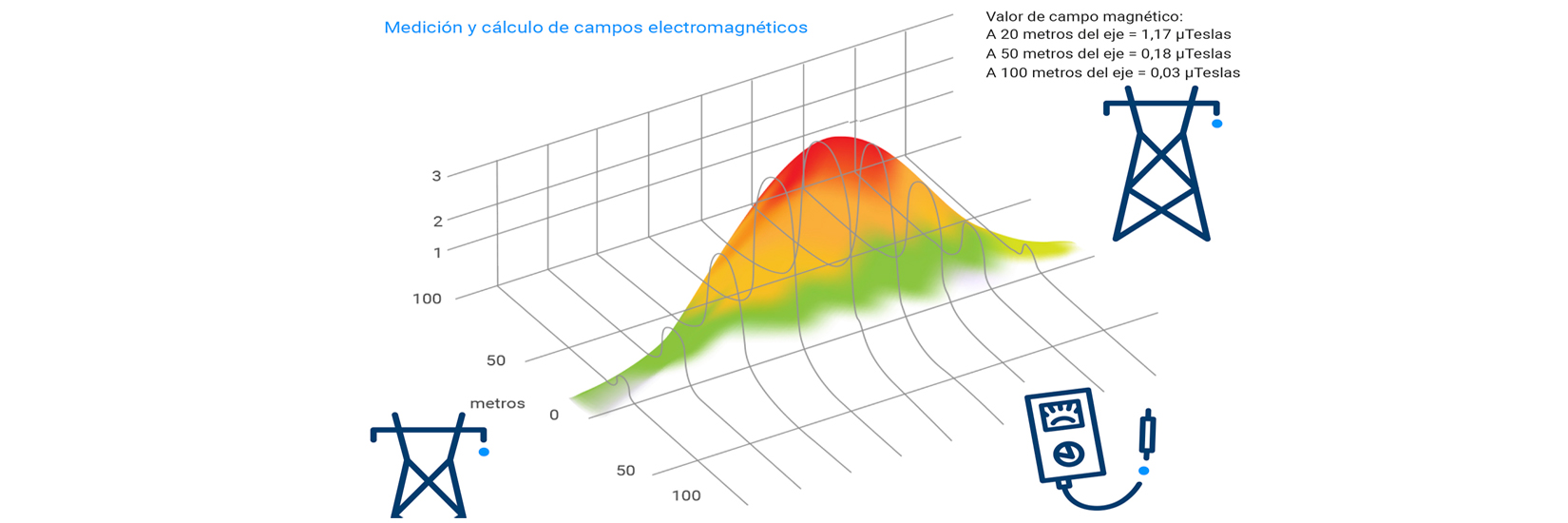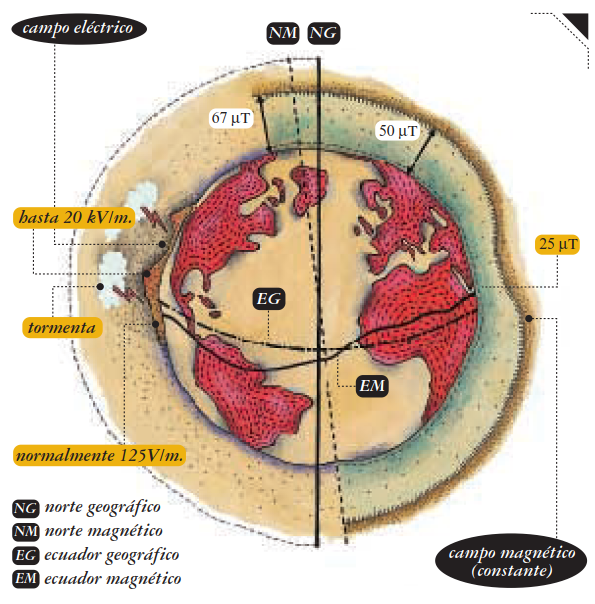For 40 years, we've been driving our country's economic and social progress. Four decades shaping Spain.
Electromagnetic fields
Electromagnetic fields
We apply criteria in the design of our facilities that keep electric and magnetic field levels at very low levels.

Commitment to health and safety
Electric fields are generated by the force that one electric charge exerts over another. Our organisms are accustomed to living with them. We experience electromagnetic fields with extremely low frequencies every day, from our hair dryers to the microwave, but also electricity lines. There are also many other natural electromagnetic fields, like that of visible light, infra-red light and natural static fields.
Electrical installations generate extremely low frequency electromagnetic fields (60 Hz or 60 Hz) that disappear at a short distance from the source.
Electromagnetic fields are one of the environmental aspects that Red Eléctrica has studied the most for more than 30 years.
The criteria that we apply in the design of our facilities ensure that the electric and magnetic field levels are well below the limits recommended by the European Council, who recommend limiting the current density to 2mA/m2 in places where it will remain for some time. The reference levels for a 50Hz electromagnetic field are 5kV/m for the electric field and 100 µT for the magnetic field.
- Construction of double circuits and transposition of phases in lines.
- We install the three phases of each circuit in inverse order to attenuate the magnetic field, countering one circuit with the other.
- The distance of the conductors to the group ensures that the values generated on the surface are well below the regulatory levels.
- New routes are intended to stay as far as possible from population hubs and isolated houses to keep their visual impact to a minimum.
Red Eléctrica’s installations register maximum values where the distance of the conductors from the ground is closest, between 3-5 kV/m for the electric field and 1-15 µT for the magnetic field in 400 kV high voltage lines.
The field intensity falls rapidly as the distance from the axis of the line increases.
- At a distance of 30 metres, the levels of the electric and magnetic fields oscillate between 0,2-2,0 kV/m and 0,1-3,0 µT respectively.
- At a distance of 100 metres, they are usually below 0,2 kV/m and 0,3 µT, respectively.
- At a distance of 30 metres, the level of the magnetic field generated by a 400 kV line is the equivalent of being 1 m away from a working vacuum cleaner (see the table below)
The values are lower for 220 kV lines:
- At the closest point to the conductors, the values are 1-3 kV/m for the electric field and 1-6 uT for the magnetic field.
- At a distance of 30 metres, the levels of the electric and magnetic fields oscillate between 0,1-0,5 kV/m and 0,1-1,5 uT, although they are generally below 0,1 kV/m and 0,2 uT at 100 metres distance or more.
At a distance of 30 metres, the level of the magnetic field generated by a 220 kV line is the equivalent of being 1 m away from a working washing machine (see the table above)
If you want to know more about electromagnetic fields
We share some studies with you.
Only Availables in Spanish
Other institutions and scientific bodies have also studied the effects of electric and electromagnetic fields generated by electricity lines.
- Assessment of the carcinogenic potential of very low-frequency electric and magnetic fields: Agencia Internacional de Investigación sobre el Cáncer (IARC).
- What the Colegio Oficial de Físicos de España says
- Guide on exposure to electromagnetic fields between 0 Hz to 300 Ghz by the International Commission on non-ionising radiation protection (ICNIRP), on which EU recommendations are based.

Electric fields are generated by the force that one electric charge exerts over another. If it is moving, the force that this field exerts is a magnetic field. Our organisms are accustomed to living with them.
Electrical installations generate extremely low frequency electromagnetic fields (60 Hz or 60 Hz) that disappear at a short distance from the source.

Electromagnetic fields surround us in our daily lives: In the sun, mobile phones, hair dryers, electric shavers, microwaves, and electricity lines.

The concern for human health has prompted analysis of potential interactions with electromagnetic fields, and this has been ongoing for over 60 years. It is one of the most widely studies subjects in history. Over 25,000 scientific articles produced (according to WHO).
The scientific community is in agreement that exposure to industrial-field electricity and magnetic fields generated by electrical installations do not pose a risk to public health.
Epidemiological factors :
Studies carried our over the last few years are conclusive and indicate that electric and magnetic field generated by high-voltage lines do not pose any danger to public health.
Biophysical factors:
Additionally, no biophysical interaction mechanism has been identified that explains how fields of such low frequency and intensity could have long-term cause effects or cause illness in human beings.
| Household appliance | 50 Hz (µT) magnetic field | ||
| 10 cm | 30 cm | 1 m | |
| Fridge | 0,06 | 0,05 | 0,02 |
| Electric shaver | 0,24 | 0,01 | 0,01 |
| Electric cooker | 0,29 | 0,11 | 0,03 |
| Alarm clock | 0,59 | 0,23 | 0,03 |
| Mobile phone | 0,80 | 0,02 | 0,02 |
| Toaster | 1,14 | 0,13 | 0,00 |
| Hair dryer | 1,34 | 0,2 | 0,01 |
| Television | 1,40 | 0,50 | 0,09 |
| Deep-fryer | 1,70 | 0,08 | 0,01 |
| Air conditioner | 1,80 | 0,38 | 0,12 |
| Chopper | 2,84 | 0,33 | 0,04 |
| Underfloor Heating | 3,01 | 0,38 | 0,02 |
| Hoover | 5,16 | 1,52 | 0,31 |
| Halogen light | 10,64 | 1,42 | 0,14 |
| Washing machine | 16,14 | 8,20 | 2,38 |
| Service drop | 16,82 | 9,52 | 2,76 |
| Microwave oven | 30,04 | 6,04 | 0,61 |
Data obtained from ‘50 Hz electric and magnetic fields’ UNESA, 2001.
Do you have any questions?
It is the range of frequencies contained in the sources. For example, when tuned to a frequency from a single-channel radio channel, such as AM, we tune the dial to one of the frequencies contained in the electromagnetic spectrum of this channel. . Being exposed to a radiofrequency field, such as AM radio, is not the same as being exposed to X-rays.
No matter the channel, the electromagnetic field value reduces over distance. Depending on the geometry and design of the source, the field reduces at a greater or reduced speed.
Usually, in linear elements, the reduction is inversely proportional to the distance. In electricity lines (more than one conductor), with the square of the distance, and in sources, to the cube of the distance.
| Measurement point | Electric field (kV/m) | Magnetic field (µT) |
| Under the conductors | 1,20 - 5,20 | 0,40 - 14,0 |
| 30 meters from the line | 0,35 - 1,28 | 0,15 - 2,85 |
| 100 metres from the line | 0,02 - 0,14 | 0,01 - 0,29 |


There is no standard distance for all electricity lines. The value varies depending on the type of line (distance of live elements to the receiver) and the power transmitted.
To a lesser extent, they also influence other characteristics of tranmission tower configuration, the number of circuits, etc. The electric field is greater for 400 kV lines than for 220 kV lines. Whilst the magnetic field depends on current intensity, so its value is determined by the power supplied.
This means that a lower voltage line can have the same magnetic field as a 400 kV line if the load carried is higher. It is estimated that at 100 m, the values generated for both the magnetic and electric field are usually negligible.
This is the case for electric fields as these installations are insulated. For magnetic fields, however, this results in field redistribution, on the axis of the field, greater than that of overhead lines. This is because the conductor is 1 m underneath our feet instead of 15 m over our heads, as in overhead lines. But they decrease much faster from the field’s axis, and are negligible a few metres away.

In all studies carried out, no significant effects on animals or plants have been detected. In particular, farm animals have been studied.
- Why do fluorescent tubes light up under electricity lines?
When a fluorescent tube gets close to an electricity line and lights up, this is due to the fact that the electric field generated by the line ionises the gas in the fluorescent tube.
When a fluorescent tube is held under a power line with one end of the tube in your hand and the other end pointed towards the power line, the tube lights up. This is a well-known phenomenon and is of no significant importance, even if it does seem spectacular.
- I have a pacemaker, can electric and magnetic fields interfere with how it functions?
Pacemakers are electronic devices and, as such, may be subject to electromagnetic interference.
These interferences depend on factors such as their programming, the strength of the electromagnetic field, the distance between the source and the pacemaker, and the current’s frequency and duration. These interferences are more common in unipolar pacemakers than in bipolar pacemakers.
In any case, there are no known cases of malfunctioning caused by travelling below a high-voltage line or by stopping next to a transformer substation.
Household appliances connected to the electricity network are not at risk of causing interferences.
Microwave ovens have an insulation system that significantly reduces the possibility of causing interference. Radio and TV generate fields with an intensity that is so low that they do not cause interference.












